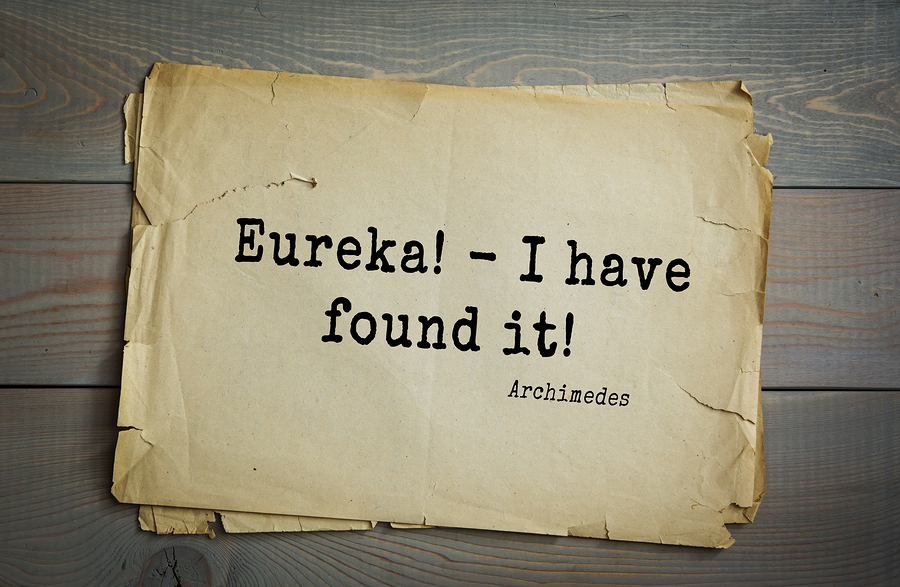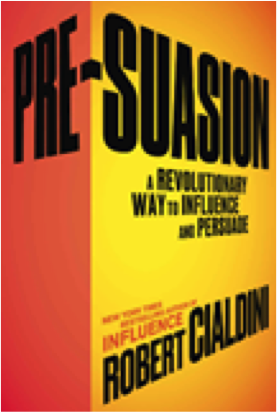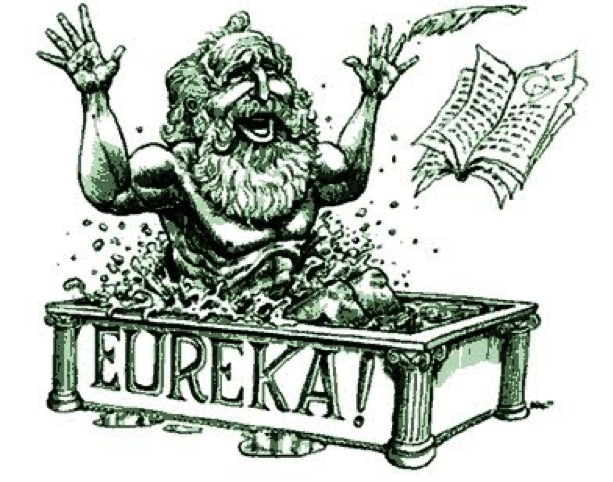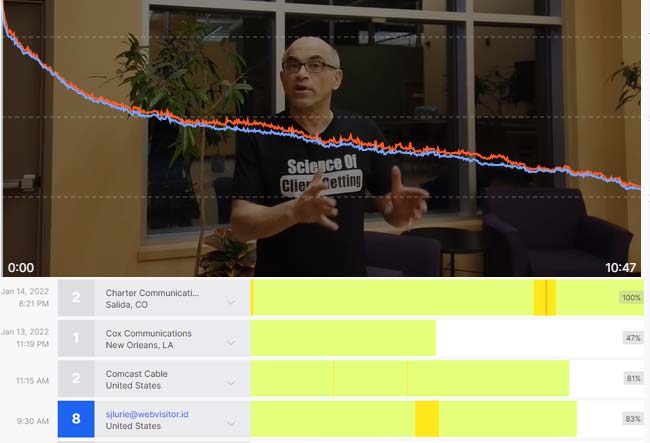What could transform one elderly scholar into such a crazed lunatic – within just a matter of seconds – that he ends up running through the busy streets, buck naked, screaming at the top of his lungs?
Was it drugs?
A San Francisco style marathon?
Just another day at Burning Man?
If you’ve heard the story of Archimedes’ ‘eureka moment’, then you know why this ancient Greek mathematician was so fired up…
But what you might NOT know is that this moment also holds the key to driving more sales for your business, and even changing the face of your marketing, altogether.

Two discoveries for the price of one …
Now that we’ve had a few thousand years to think about it, a couple things are clear.
First, Archimedes could have explained his findings in dry, boring detail… simply by walking into the King’s court and laying it all out in logical fashion. But that doesn’t make a very good story. So who would bother sharing that, right?
And second, by accidentally sensationalizing this discovery, the discovery, itself, became much more approachable. And I’ll bet you 10 Drachma, it didn’t take more than a few days before every other academic was reproducing this experiment, far and wide.
Think about the implications of this in your business …
If you produced a webinar that went to great pains to explain your technologies or business services – without any kind of dramatization – there’s a very high likelihood that you’re the only one who’s going to enjoy it.
The fact is, most people are bored by ‘book report’ style presentations…
And that means, you might’ve just wasted a lot of precious time and resources.
But if you had dramatized your main points… so they were much more memorable, and easily passed from one person to another – just like tasty morsels of gossip – then you’d really be getting your money’s worth, wouldn’t you?
Then you’d be engaging your audience at a higher level and, maybe even, benefiting from the ‘viral effect’ of your viewers sharing their thoughts about your products and services with their peers.
Now, I’m not talking about “viral marketing” here.
I don’t want to launch into a discussion of how the Dollar Shave Club got famous because people loved their overacting.
And I’m not talking about branding or publicity stunts like SpaceX’s Starman… although that would certainly help your business, if you can afford it.
No. I’m talking about a much more practical, affordable strategy of enlisting your audience’s creativity by engineering curiosity inducing stories throughout your marketing.
We want people to focus on ‘Why the heck was Archimedes running down the street naked?’, and then think about the story until they come to their own ‘eureka moment’, instead of just rubbernecking at the spectacle of it all.
The point being: curiosity leads people to conclusions. So if you’re able to systematically engage that curiosity – then you don’t have to explain that much, at all!

So how can you engineer your own ‘eureka moments’?
First off, it’s important to get out of the ‘how to’ mindset when you sit down to write.
Explaining is pain-ing, as I like to say.
Because even though people want to know how to do things… and you want to help them by sharing your hard-won lessons… if it’s not memorable, then you’re not serving your prospect’s best interests very well, are you?
Because without engagement, they’re probably not going to take any action, anyway…
So how can you dramatize your story? How can you get your audience to fill-in-the blanks, so they’re actively participating in the creative process?
 In Robert Cialdini’s book, Pre-Suasion, he recommends a 6-step process:
In Robert Cialdini’s book, Pre-Suasion, he recommends a 6-step process:
1. Start by posing a mystery
2. Then deepen the mystery
3. Home in on the proper explanation by considering (and offering evidence against) alternative explanations
4. Provide a clue to the proper explanation
5. Resolve the mystery
6. And finally, draw implications from the phenomenon under study
Sounds simple enough…
But ‘the Devil’s in the details’, as always …
So let’s take a look at a live example, so I can show you exactly how to use these steps to help ‘keep your audience guessing’, and maintain peak levels of engagement.
Recently, Daniel put together this 12-minute video following Cialdini’s curiosity inducing framework, to introduce people to the idea of fellowship-based marketing.
The results?
As you see in the heat-map, above, viewers are loving it.
Average viewer engagement is at 52% and conversion is through the roof.
Obviously, this formula works.
So I recommend you watch this a few times and take notes.
See if you can follow along using Cialdini’s framework, from above.
Pay special attention to how he transitions from one section to the next.
And start thinking about – and scripting out – an introduction to YOUR own products and services, in the same way.
Because engagement means everything to your bottom line …
There’s an old ‘yardstick’ of engagement called the 3:30:3:30 rule.
This says that if people stick with your message for more than 3 seconds, then they’ll give you the next 30 seconds.
If you make it past that, they’ll give you 3 minutes.
And if you make it past THAT, they’re likely to give you the next 30 minutes of their time.
Think about the implications here.
Higher engagement levels are THE KEY to growing your bottom-line profits, because THAT’S what helps you bring in more and better qualified prospects.
And if you can do that, using automation, that means you can have a lot more time and resources to go after even larger audiences… and continue scaling out.
This is what we mean by ‘rolling out a campaign’ in the direct-response world.
So ask yourself… if I could dramatically increase my engagement levels… so I could be more successful with my campaigns… and have the resources to ‘roll out those campaigns’ in a big way – what would that mean to my business’ future?
How would THAT help me to quickly dominate my niche?
What would THAT do for my business development?
A profitable perspective shift …
And that brings me to an important perspective shift on selling; one that will make your marketing more profitable… and change how you think about yourself, as a marketer, for the better.
Marketing isn’t about manipulation. It’s not all about big promises and persuasion.
To my mind, marketing is about being so devoted to the cause your market cares about, that you know you’d be ABSOLUTELY derelict in your duties if you AREN’T doing everything you can to help the people you really care about get what they really want…
You do that by clearly presenting the connection between your market’s problems and your solutions, of course.
But those connections are often ignored when you tell people what to think or feel… or if you drone on about why your ‘amazing new creation’ is so great.
Discovery is so much more meaningful when it happens naturally…
… When your prospects experience the pleasure of that discovery, on their own.
So stop thinking of yourself as a persuader… as a promiser… or promoter.
You’re just the one who creates the ideal conditions for discovery…
You’re the one who’s done the hard work of research and planning…
… Of figuring out what your market really wants…
… And then organized all the most powerful, thought-provoking ideas on a silver platter for your reader’s delight…
You’re just the one who draws the bath, so to speak.

And that’s just my way of saying “selling” shouldn’t take a lot of force.
Because when you’re talking to the right person at the right time, with the right message, it’s only natural that they’re the one driving the creative process. They’re the one making the sale, for you.

Leave a Reply